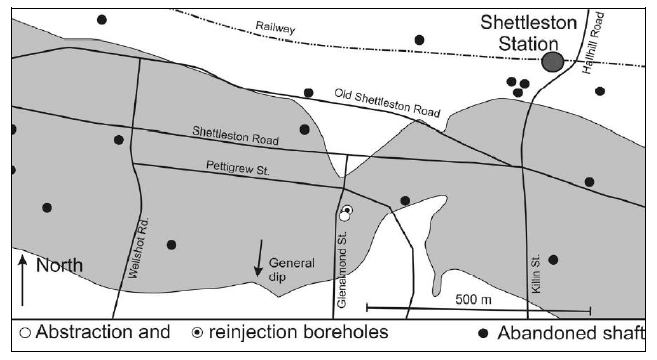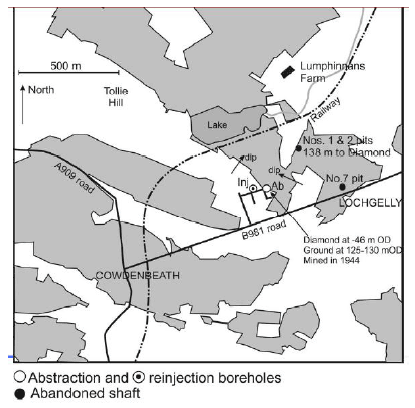Potential for deep geothermal energy in Scotland: study volume 2
This independent study investigates the potential for deep geothermal energy in Scotland and the steps necessary for commercialisation.
Appendix 2 Existing mine water schemes in Scotland
The following information is extracted from Ó'Dochartaigh (2009).
There are only two known current schemes in Scotland that use mine water as a source of heat: one at Shettleston in east Glasgow and one at Lumphinnans in Fife. Both were at least partly designed by John Gilbert Architects ( http://www.johngilbert.co.uk/).
Shettleston, Glasgow
This open loop ground source heat scheme was completed in 1999 and serves 16 new-build dwellings (two storey houses and two/three storey flats). The heating system is based on mine water from flooded coal mine workings in the Glasgow Ell Seam beneath the site, which is abstracted via a borehole approximately 100 m deep. Mine water at 12 °C is circulated through a water-to-water heat pump, heating water to 55°C which is output to an insulated thermal storage tank with 10 m 3 volume. The hot water in this tank is supplemented by a side loop to 36 m 2 of solar collector panels which gives additional energy gain to the thermal tank, mostly in the afternoon: from the available details, however, it doesn't seem that these solar panels provide a large proportion of the supplied heat. From the thermal store, water is distributed to hot water central heating radiators and through closed exchanger coils to domestic hot water storage cylinders (which are fitted with electric immersion heaters to further boost water temperature if necessary). The total annual heating and hot water cost per dwelling is £90-£100 (Banks et al., 2003, Banks et al., 2008).
Waste water from the system is discharged below the water table via a shallower re-injection borehole, at 3°C (Banks et al., 2008).
Figure A1 Map illustrating workings in the Ell Coal Seam below the Shettleston ground source heat scheme in east Glasgow, with sites of abandoned shafts and the abstraction and re-injection boreholes of the scheme also marked (diagram from Banks et al., 2008 / Holymoor Consultancy)

Lumphinnans, Fife
This open loop ground source heat scheme was retro-fitted to a 1950s apartment block of 18 dwellings, and completed in 2000/01. Mine water is pumped from flooded coal mine workings in the Jersey / Diamond seam beneath the site via a 172 m deep borehole. The temperature of the pumped mine water is variously reported as 12°C (Banks et al., 2008) or 14.5°C (Banks et al., 2003). It is circulated through a water-to-water heat pump, heating water to 55°C which is output to a thermal storage tank. This feeds domestic hot water (which also includes supplementary immersion heaters) and central heating systems (Banks et al., 2003; Banks et al., 2008).
Waste water at 3°C is returned to a permeable stratum above the flooded workings from which water is abstracted, via a shallower re-injection borehole some 100 m away from the abstraction borehole (Banks et al., 2003).
Figure A2 Map illustrating workings in the Jersey / Diamond coal seam beneath the Lumphinnans ground source heat scheme in Fife, with sites of abandoned shafts and the abstraction and re-injection boreholes of the scheme also marked (diagram from Banks et al., 2008 / Holymoor Consultancy).

Contact
There is a problem
Thanks for your feedback